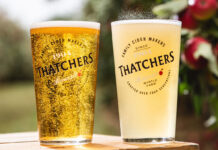Category continues to create opportunities for trade, say producers

CIDER has been going from strength to strength in recent years, with value sales continuing to grow in the Scottish on-trade, according to data firm CGA.
And cider producers insist there is still plenty room for growth as consumers embrace a wide range of products and formats.
Martin Thatcher, fourth generation cider maker at Thatchers Cider, said the category is “definitely flourishing” in Scotland.
“It’s a great sector to be involved with – in growth and with plenty of opportunity for innovation, it generates interest from both people within the trade and consumers,” he said.
Cider drinkers are more adventurous than ever and are seeking out provenance.
Thatcher highlighted a particular growth in sales of premium apple ciders.
“It has been interesting to see how newer cider drinkers, male and female, are exploring new cider styles once they have been introduced via the sweeter fruit and flavoured ciders,” he said.
“Particularly in the on-trade they are able to discover a wealth of cider styles available from heritage producers such as ourselves at Thatchers.”
Arran Brewery owner Gerald Michaluk, who plans to enter the cider market this winter (see page 22), agreed that consumers are “becoming more adventurous” when it comes to cider, “seeking provenance more than ever”.
Along with premium apple, packaged cider in general is said to be performing well in the Scottish on-trade.
Rob Calder of Swedish brand Kopparberg said packaged cider is up “almost 5% year on year”.
This growth could perhaps be attributed to changing consumer flavour preferences in recent years, according to Calder.
It’s important that licensees choose an appropriate cider range for their pub.
“Cider has long benefited from the trend towards lighter, sweeter flavours, and Kopparberg has seen significant growth recently in our lighter flavoured products, like Elderflower & Lime and Cloudberry,” he said.
“We’ll continue to support these variants across the trade.”
Highlighting a report from data firm Mintel, Calder outlined two main “types of consumer” that are key to the cider market.
The “traditionalist” drinker, “more interested in apple ciders on draught and are more likely to be older consumers” and “new enthusiasts”, who Calder said are “the drinkers who are most likely to be spending money in the on-trade, more likely to try new flavours and more likely to trade up to premium drinks”.
Knowing your customer is key to sales, according to Peter Stuart, cider maker at Thistly Cross.
“It’s important that licensees choose appropriately for their pub; looking for ciders that they appreciate, respect and know will appeal to their customers,” said Stuart.
“Presentation is important but it’s not just about the products that have the biggest commercial push.
“They need to be selective to make sure they offer products of distinction, something unique that differentiates their pub from the rest.
“Products need to earn their space, and we find that offering a main, more traditional cider on keg works well alongside a more varied bottled selection in the fridge.”
Bottles can also be an effective way to “test” a new cider brand or product before investing in a keg, said Stuart.
“And once someone has had a good experience with a particular variety of cider, they’re more inclined to experiment a little and try something new,” he said.
And despite the huge range of products in the market there’s more innovation to come, according to Graham Coull, managing director of VC2 Brands, the firm behind Stivy’s Original Cider.
“I do not think that the market has reached its saturation point,” said Coull. “There are so many flavour options to explore, and the consumers are becoming more adventurous and willing to try more unusual flavours.”
Having the right range may be crucial, but it’s not the whole battle, according to Andrew Turner, on-trade category and trade marketing director for Heineken, the firm behind Strongbow and Bulmers ciders.
Referring to an “explosion of choice” in the cider category over the last decade, Turner said it is “imperative that licensees merchandise both draught and modern packaged ciders correctly”.
Many customers are receptive to recommendations from bar staff.
Heineken recommends operators focus on “four pillars” to drive cider sales: the ‘importance of chilled’, visibility, staff knowledge and consumer engagement.
“It’s imperative that both draught and modern packaged ciders are kept chilled,” said Turner.
“Draught cider should be stored in a cool area and where possible pumps should offer an ‘extra cold’ serve, whilst bottled ciders should be kept refrigerated.
“To maximise the significant profit opportunity, licensees should always ensure there is sufficient space in the fridge to display them clearly as a cluttered display will confuse your customers.”
In addition to displaying cider brands prominently in the fridge, Turner said it is important to make use of point of sale materials and displays to draw attention to an outlet’s cider range.
And staff knowledge is said to be crucial. “Ensuring your staff are knowledgeable when it comes to your cider range is also a great way of influencing decisions,” said Turner.
He added that a ‘cider of the month’ offer can also help increase engagement with consumers.
























